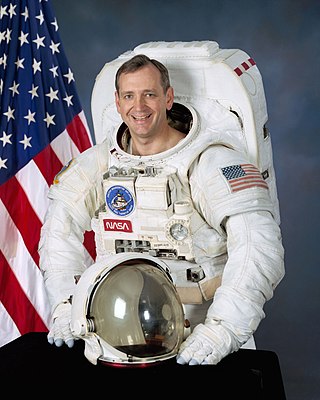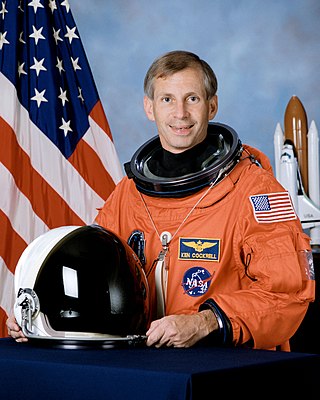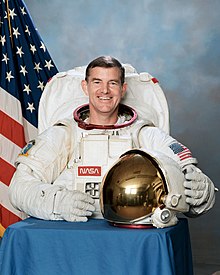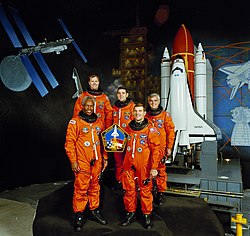
Thomas Dale Akers is a former American astronaut in NASA's Space Shuttle program.

Kenneth Dwane "Sox" Bowersox is a United States Navy officer, and a former NASA astronaut. He is a veteran of five Space Shuttle launches and an extended stay aboard the International Space Station. When he launched on STS-73 at the age of 38 years and 11 months, he became the youngest person to command a Space Shuttle.

Kenneth Dale "Taco" Cockrell is a retired American astronaut, engineer and a veteran of five Space Shuttle missions. He served as Chief of the Astronaut Office from 1997 to 1998.

William McMichael "Bill" Shepherd, , is an American former Navy SEAL, aerospace, ocean, and mechanical engineer, and NASA astronaut, who served as commander of Expedition 1, the first crew on the International Space Station. He is a recipient of the Congressional Space Medal of Honor.

Nancy Jan Davis is a former American astronaut. A veteran of three space flights, Davis logged over 673 hours in space. She is now retired from NASA.

Curtis Lee "Curt" Brown Jr. is a former NASA astronaut and retired United States Air Force colonel.

Richard James Hieb is a former NASA astronaut and a veteran of three Space Shuttle missions. He was a mission specialist on STS-39 and STS-49, and was a payload commander on STS-65. After leaving NASA he worked at AlliedSignal and Orbital before spending 14 years as an executive at Lockheed Martin. He is currently a faculty member in the University of Colorado Boulder Smead Aerospace Engineering Sciences Department.

Michael Richard Clifford was a United States Army officer and NASA astronaut. Clifford was a Master Army Aviator and logged over 3,400 hours flying in a wide variety of fixed and rotary winged aircraft. He retired from the U.S. Army at the rank of lieutenant colonel. He logged six hours of spacewalk time over three Space Shuttle missions. He was also one of the first people to conduct a spacewalk while docked to an orbiting space station: that spacewalk was conducted during STS-76, while docked at the Russian space station Mir.

Brian Duffy is a retired U.S. Air Force colonel and a former NASA astronaut. He flew aboard four Space Shuttle missions.

Linda Maxine Godwin is an American scientist and retired NASA astronaut. Godwin joined NASA in 1980 and became an astronaut in July 1986. She retired in 2010. During her career, Godwin completed four space flights and logged over 38 days in space. Godwin also served as the assistant to the director for exploration, Flight Crew Operations Directorate at the Johnson Space Center. Since retiring from NASA, she accepted the position of professor in the Department of Physics and Astronomy at the University of Missouri.

Gregory Jordan "Greg" Harbaugh is an aeronautical/astronautical engineer and former NASA astronaut. He flew on four space shuttle missions as a mission specialist with responsibilities that included Remote Manipulator System (RMS) operation and Extravehicular Activity (EVAs). He performed three spacewalks during the shuttle missions including in support of repair/refurbishment of the Hubble Space Telescope.

Pierre Joseph Thuot is a retired United States Navy captain and NASA astronaut. He went into space three times, spending over 650 hours in space, including over 15 hours in three space walks. He is a former U.S. record holder for time spent on one spacewalk, and participated in the first three-person spacewalk.

Yury Vladimirovich Usachov is a former cosmonaut who resides in Star City, Moscow. Usachov is a veteran of four spaceflights, including two long-duration missions on board the Mir Space Station and another on board the International Space Station. During his career, he also conducted seven spacewalks before his retirement on April 5, 2004.

Expedition 2 was the second long-duration spaceflight aboard the International Space Station, immediately following Expedition 1. Its three-person crew stayed aboard the station from March to August 2001. In addition to station maintenance, the crew assisted in several station assembly missions, welcomed the first space tourist Dennis Tito, and conducted some scientific experiments.

Soichi Noguchi is a Japanese aeronautical engineer and former JAXA astronaut. His first spaceflight was as a mission specialist aboard STS-114 on 26 July 2005 for NASA's first "return to flight" Space Shuttle mission after the Columbia disaster. He was also in space as part of the Soyuz TMA-17 crew and Expedition 22 to the International Space Station (ISS), returning to Earth on 2 June 2010. He is the sixth Japanese astronaut to fly in space, the fifth to fly on the Space Shuttle, and the first to fly on Crew Dragon.

Akihiko Hoshide is a Japanese engineer, JAXA astronaut, and former commander of the International Space Station. On August 30, 2012, Hoshide became the third Japanese astronaut to walk in space.

Michael Reed Barratt is an American physician and a NASA astronaut. Specializing in aerospace medicine, he served as a flight surgeon for NASA before his selection as an astronaut, and has played a role in developing NASA's space medicine programs for both the Shuttle-Mir Program and International Space Station. His first spaceflight was a long-duration mission to the International Space Station, as a flight engineer in the Expedition 19 and 20 crew. In March 2011, Barratt completed his second spaceflight as a crew member of STS-133. Barratt will pilot the SpaceX Crew-8 mission in spring 2024.

Stephen Gerard"Steve"Bowen is a United States Navy submariner and a NASA astronaut; he was the second submariner to travel into space. Bowen has been on four spaceflights, three of which were Space Shuttle missions to the International Space Station. His first mission, STS-126, took place in November 2008, and his second was STS-132 in May 2010. His third was STS-133 in February 2011, and his fourth was SpaceX Crew-6 in March 2023.

Benjamin Alvin Drew is a United States Air Force officer and a former NASA astronaut. He has been on two spaceflights; the first was the Space Shuttle mission STS-118 to the International Space Station, in August 2007. Drew's second spaceflight took place in March 2011 on STS-133, another mission to the International Space Station. STS-133 was Space Shuttle Discovery's final mission. Drew took part in two spacewalks while docked to the station. Drew was the final African-American to fly on board a Space Shuttle, as the final two Space Shuttle missions, STS-134 and STS-135, had no African-American crew members.

NASA Astronaut Group 12 was a group of 15 astronauts announced by NASA on June 5, 1987.






















